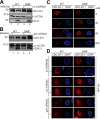Fate specification and tissue-specific cell cycle control of the Caenorhabditis elegans intestine
- PMID: 20053685
- PMCID: PMC2828960
- DOI: 10.1091/mbc.e09-04-0268
Fate specification and tissue-specific cell cycle control of the Caenorhabditis elegans intestine
Abstract
Coordination between cell fate specification and cell cycle control in multicellular organisms is essential to regulate cell numbers in tissues and organs during development, and its failure may lead to oncogenesis. In mammalian cells, as part of a general cell cycle checkpoint mechanism, the F-box protein beta-transducin repeat-containing protein (beta-TrCP) and the Skp1/Cul1/F-box complex control the periodic cell cycle fluctuations in abundance of the CDC25A and B phosphatases. Here, we find that the Caenorhabditis elegans beta-TrCP orthologue LIN-23 regulates a progressive decline of CDC-25.1 abundance over several embryonic cell cycles and specifies cell number of one tissue, the embryonic intestine. The negative regulation of CDC-25.1 abundance by LIN-23 may be developmentally controlled because CDC-25.1 accumulates over time within the developing germline, where LIN-23 is also present. Concurrent with the destabilization of CDC-25.1, LIN-23 displays a spatially dynamic behavior in the embryo, periodically entering a nuclear compartment where CDC-25.1 is abundant.
Figures







References
-
- Ashcroft N., Golden A. CDC-25.1 regulates germline proliferation in Caenorhabditis elegans. Genesis. 2002;33:1–7. - PubMed
-
- Ashcroft N. R., Srayko M., Kosinski M. E., Mains P. E., Golden A. RNA-Mediated interference of a cdc25 homolog in Caenorhabditis elegans results in defects in the embryonic cortical membrane, meiosis, and mitosis. Dev. Biol. 1999;206:15–32. - PubMed
-
- Bei Y., Hogan J., Berkowitz L. A., Soto M., Rocheleau C. E., Pang K. M., Collins J., Mello C. C. SRC-1 and Wnt signaling act together to specify endoderm and to control cleavage orientation in early C. elegans embryos. Dev. Cell. 2002;3:113–125. - PubMed
Publication types
MeSH terms
Substances
Grants and funding
LinkOut - more resources
Full Text Sources
Molecular Biology Databases
Research Materials

